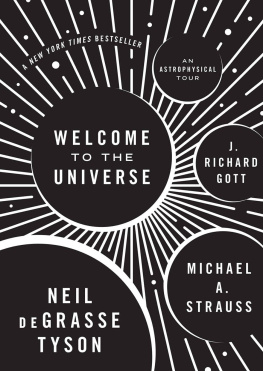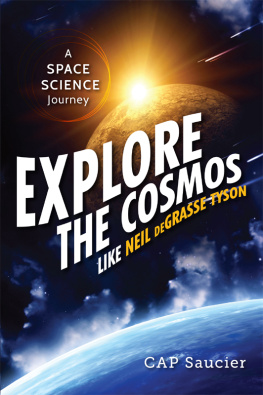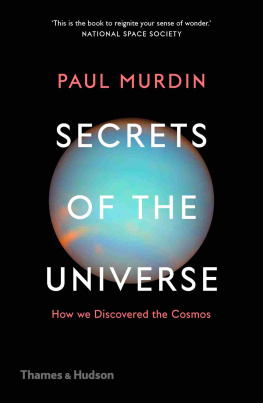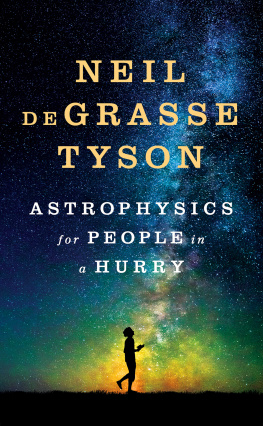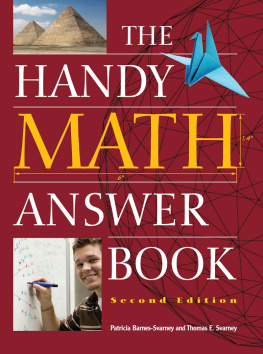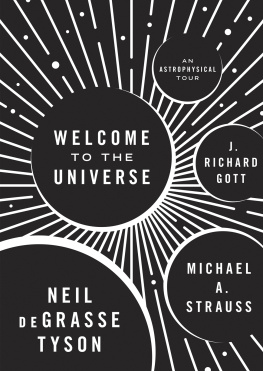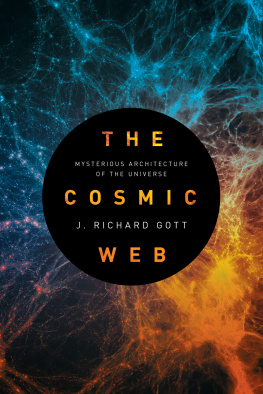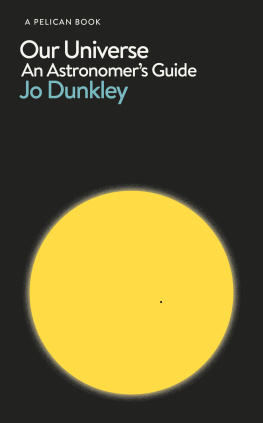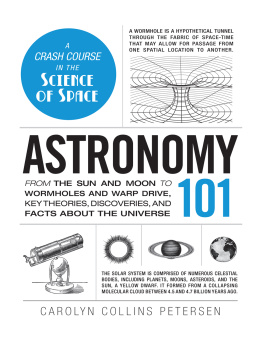
Copyright 2016 by Neil deGrasse Tyson, Michael A. Strauss, and J. Richard Gott
Requests for permission to reproduce material from this work
should be sent to Permissions, Princeton University Press
Published by Princeton University Press
41 William Street, Princeton, New Jersey 08540
In the United Kingdom: Princeton University Press
6 Oxford Street, Woodstock, Oxfordshire OX20 1TR
press.princeton.edu
Jacket and book design by Chris Ferrante
All Rights Reserved
Library of Congress Cataloging-in-Publication Data
Names: Tyson, Neil deGrasse. | Strauss, Michael Abram. | Gott, J. Richard.Title: Welcome to the universe : an astrophysical tour / Neil deGrasse Tyson, Michael A. Strauss, and J. Richard Gott.
Description: Princeton : Princeton University Press, 2016. | Includes bibliographical references and index.
Identifiers: LCCN 2016013487 | ISBN 9780691157245 (hardback : alk. paper)
Subjects: LCSH: CosmologyPopular works. | StarsPopular works. | Relativity (Physics)Popular works.
Classification: LCC QB982 .T974 2016 | DDC 523.1dc23 LC record available at
https://lccn.loc.gov/2016013487
British Library Cataloging-in-Publication Data is available
This book has been composed in Adobe Text Pro and Trade Gothic LT Std
Printed on acid-free paper.
Printed in the United States of America
10 9 8 7 6 5 4 3 2 1
To the memories of Lyman Spitzer, Jr., Martin Schwarzschild,
Bohdan Paczyski, and John Bahcall, indelible influences on
the three of us in astrophysics research and education.
CONTENTS
1THE SIZE AND SCALE OF THE UNIVERSE
Neil deGrasse Tyson
2FROM THE DAY AND NIGHT SKY TO PLANETARY ORBITS
Neil deGrasse Tyson
3NEWTONS LAWS
Michael A. Strauss
4HOW STARS RADIATE ENERGY (I)
Neil deGrasse Tyson
5HOW STARS RADIATE ENERGY (II)
Neil deGrasse Tyson
6STELLAR SPECTRA
Neil deGrasse Tyson
7THE LIVES AND DEATHS OF STARS (I)
Neil deGrasse Tyson
8THE LIVES AND DEATHS OF STARS (II)
Michael A. Strauss
9WHY PLUTO IS NOT A PLANET
Neil deGrasse Tyson
10THE SEARCH FOR LIFE IN THE GALAXY
Neil deGrasse Tyson
11THE INTERSTELLAR MEDIUM
Michael A. Strauss
12OUR MILKY WAY
Michael A. Strauss
13THE UNIVERSE OF GALAXIES
Michael A. Strauss
14THE EXPANSION OF THE UNIVERSE
Michael A. Strauss
15THE EARLY UNIVERSE
Michael A. Strauss
16QUASARS AND SUPERMASSIVE BLACK HOLES
Michael A. Strauss
17EINSTEINS ROAD TO RELATIVITY
J. Richard Gott
18IMPLICATIONS OF SPECIAL RELATIVITY
J. Richard Gott
19EINSTEINS GENERAL THEORY OF RELATIVITY
J. Richard Gott
20BLACK HOLES
J. Richard Gott
21COSMIC STRINGS, WORMHOLES, AND TIME TRAVEL
J. Richard Gott
22THE SHAPE OF THE UNIVERSE AND THE BIG BANG
J. Richard Gott
23INFLATION AND RECENT DEVELOPMENTS IN COSMOLOGY
J. Richard Gott
24OUR FUTURE IN THE UNIVERSE
J. Richard Gott
APPENDIX 1
Derivation of E=mc2
APPENDIX 2
Bekenstein, Entropy of Black Holes, and Information
PREFACE
When my granddaughter Allison was born, one of the first things I said to her was Welcome to the universe! Its something my coauthor Neil Tyson has said many times on radio and TV. Indeed it is one of Neils signature sayings. When you are born, you become a citizen of the universe. It behooves you to look around and get curious about your surroundings.
Neil felt a call from the universe on a first visit to the Hayden Planetarium in New York City when he was 9 years old. As a city kid, he saw the glories of the nighttime sky for the first time displayed on the planetarium dome and decided at that moment to become an astronomer. Today he is the director of that institution.
In fact, we are all touched by the universe. The hydrogen in your body was forged in the birth of the universe itself, while the other elements in your body were made in distant, long-dead stars. When you call a friend on your mobile phone, you should thank astronomers. Mobile phone technology depends on Maxwells equations, whose verification depended on the fact that astronomers had already measured the speed of light. The GPS that tells your phone where you are and helps you navigate relies on Einsteins theory of general relativity, which was verified by astronomers measuring the deflection of starlight passing near the Sun. Did you know there is an ultimate limit to how much information can ever be stored in a 6-inch-diameter hard drive and that it depends on black hole physics? At a more mundane level, the seasons you experience every year depend directly on the tilt of Earths axis relative to the plane of its orbit around the Sun.
This book aims to better acquaint you with the universe in which you live. The idea for this book started when the three of us taught a new undergraduate course on the universe for nonscience majors at Princeton Universityfor students who perhaps had never taken a science course before. For this purpose, Neta Bahcall, our colleague and director of undergraduate studies, selected Neil deGrasse Tyson, Michael Strauss, and me. Neils genius at explaining science to nonscientists was apparent, Michael had just discovered the most distant quasar yet found in the universe, and I had just received the universitys Presidents Award for Distinguished Teaching. The course was launched with great fanfare and attracted so many students that we couldnt hold it in our own building and had to move it to the biggest lecture hall in the Physics Department. Neil talked about Stars and Planets, Michael talked about Galaxies and Quasars, and I talked about Einstein, Relativity, and Cosmology. The course was mentioned in Time magazine, when Time honored Neil as one of the 100 most influential people in the world in 2007. Among other features of this book, you will get to know Neil as a professor, telling you things he tells his students.
FIGURE 0.1. The three authors, left to right: Strauss, Gott, and Tyson.
Photo credit: Princeton, Denise Applewhite
After we had taught the course for a number of years, we decided to put its ideas down in the form of a book for readers who hungered for a deeper understanding of the universe.
We give you a tour of the universe from an astrophysical point of view, from the point of view of trying to understand what is going on. We tell you how Newton and Einstein got their greatest ideas. You know Stephen Hawking is famous. But we tell you what made him famous. The great movie of his life story, The Theory of Everything, won Eddie Redmayne a best actor Oscar for his compelling portrayal of Hawking. It shows Hawking having his greatest idea by simply staring into the fireplace and having it suddenly come to him. We tell you what the movie left out: how Hawking didnt believe the work of Jacob Bekenstein, but he ended up reaffirming it and taking it to an entirely new conclusion. And thats the same Jacob Bekenstein who found the ultimate limit for how much information could be stored on your 6-inch-diameter hard drive. Its all connected. In this book, of all the topics in the universe, we focus particularly on those we are most passionate about, and we hope our excitement will be contagious.

